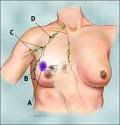Lumpectomy( Lump removal) can also be known as breast-conserving surgery as it is making every attempt to preserve as much of the shape and size of the breast as possible. It tends to remove only the cancerous lump rather than the entire breast. This type of surgery makes “ wide local excision”. An incision (cut) is made into the skin to reach the tumour, but the skin is not removed unless the tumour sticks to it. Then, the tumour and a small edge of the surrounding cancer-free breast cell are then removed. The nipple and areola(circular area surrounding the nipple) are left intact.
In this surgery, the surgeon marks the breast with six different colours, one for each side so that the surgeon can notify which edge corresponds with a given edge within the surgical cavity during the surgery. An reexcision (second or third cut) will be performed when one or more edges have positive margins (area that is infected by the cancer). The six-colour inking will allow surgeon to cut additional tissue selectively from the appropriate area. The inked specimen is then sent to mammography and assessed so that the surgeon can perform appropriate action to eliminate the probability for the patient to undergo a second surgery.
This technique minimizes the amount of cancerous tissue removed and helps to ensure clean and safe area or edge of the breast. Thus, when less tissue is removed, the breast will look and sense much like the original breast.
After the recovery from lumpectomy, it may take several weeks for the initial discomfort in patient to ease. Fortunately, lumpectomy does not affect the underlying pectoral muscles. So, after the discomfort subsides, patient will not notice any impact on physical activity or exercise restrictions.
Lumpectomy
